LC567 Ethics in Social Science: Examining the Abortion Ethical Dilemma
VerifiedAdded on 2023/06/14
|10
|3376
|404
Report
AI Summary
This report delves into the ethical and moral dilemma of abortion within the framework of social science, exploring various ethical principles, professional codes of conduct, and personal values. It addresses the complexities of teenage pregnancies, the conflict between personal and professional ethics for healthcare providers, and the violation of human rights. The report also examines ethical theories such as utilitarianism, deontological ethics, and consequentialism, applying them to the abortion debate. It further discusses the relationship between ethics and professional codes, highlighting principles like justice, autonomy, maleficence, and non-maleficence. The report concludes by emphasizing the multifaceted nature of the abortion issue and the importance of considering diverse perspectives in ethical decision-making. The document is contributed by a student and available on Desklib, a platform offering study tools and resources for students.
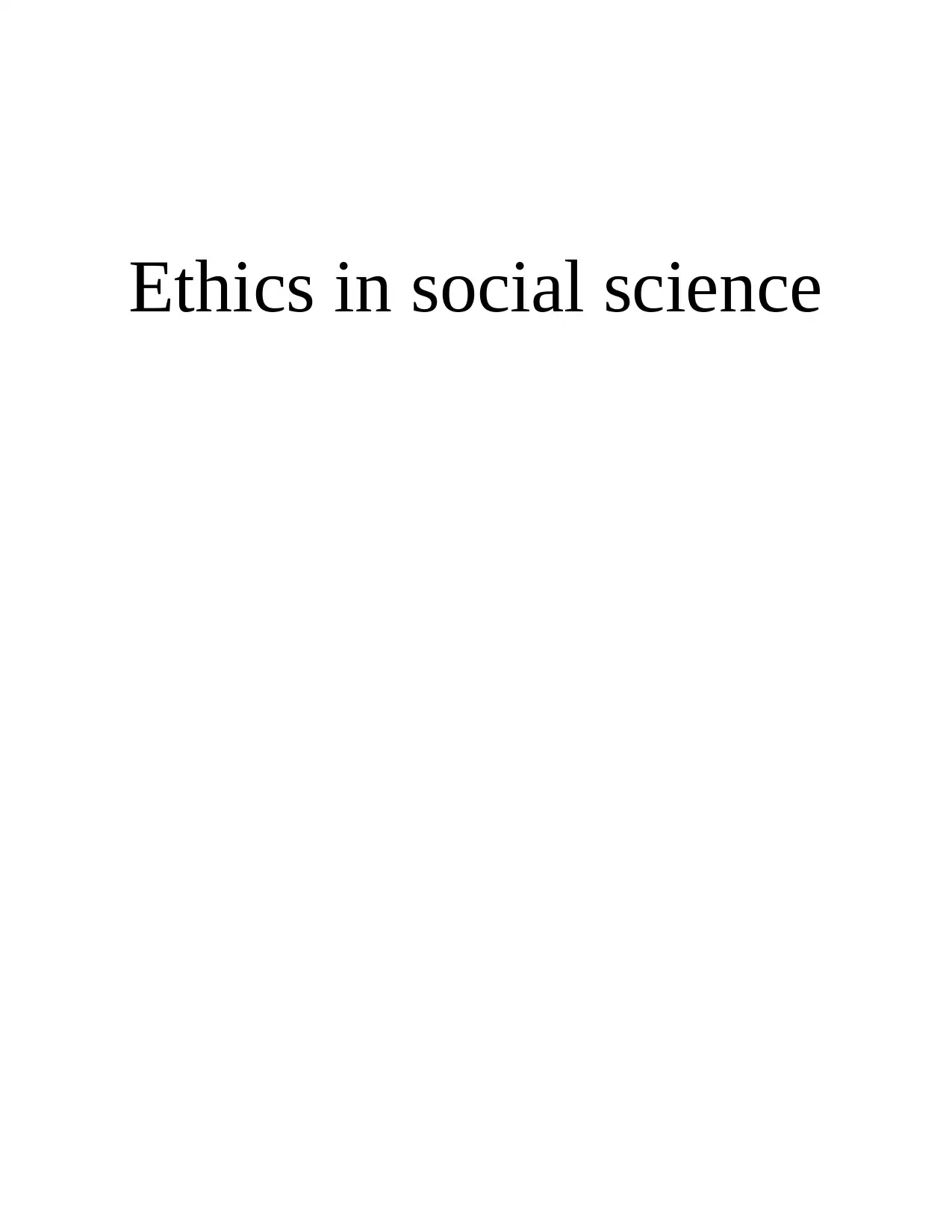
Ethics in social science
Paraphrase This Document
Need a fresh take? Get an instant paraphrase of this document with our AI Paraphraser
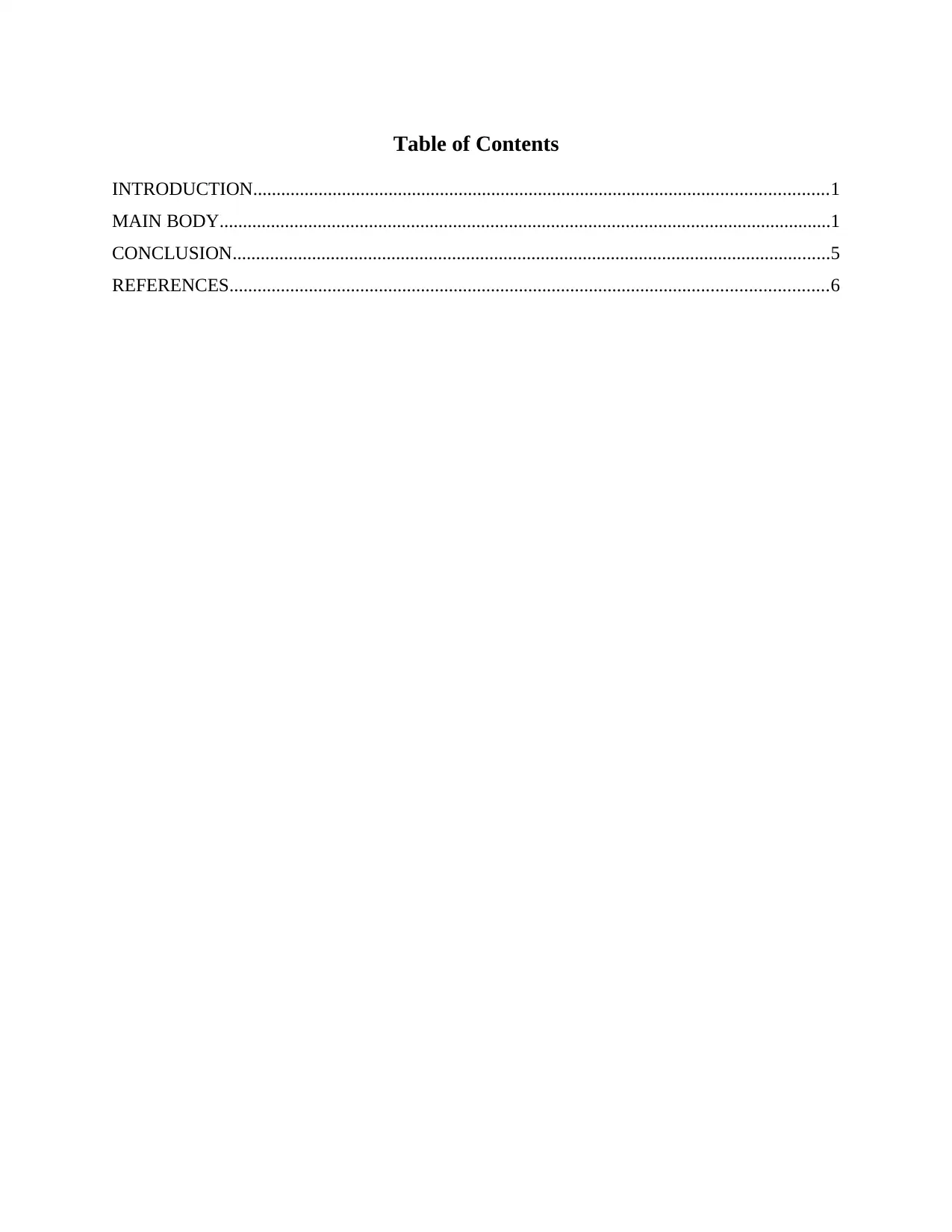
Table of Contents
INTRODUCTION...........................................................................................................................1
MAIN BODY...................................................................................................................................1
CONCLUSION................................................................................................................................5
REFERENCES................................................................................................................................6
INTRODUCTION...........................................................................................................................1
MAIN BODY...................................................................................................................................1
CONCLUSION................................................................................................................................5
REFERENCES................................................................................................................................6
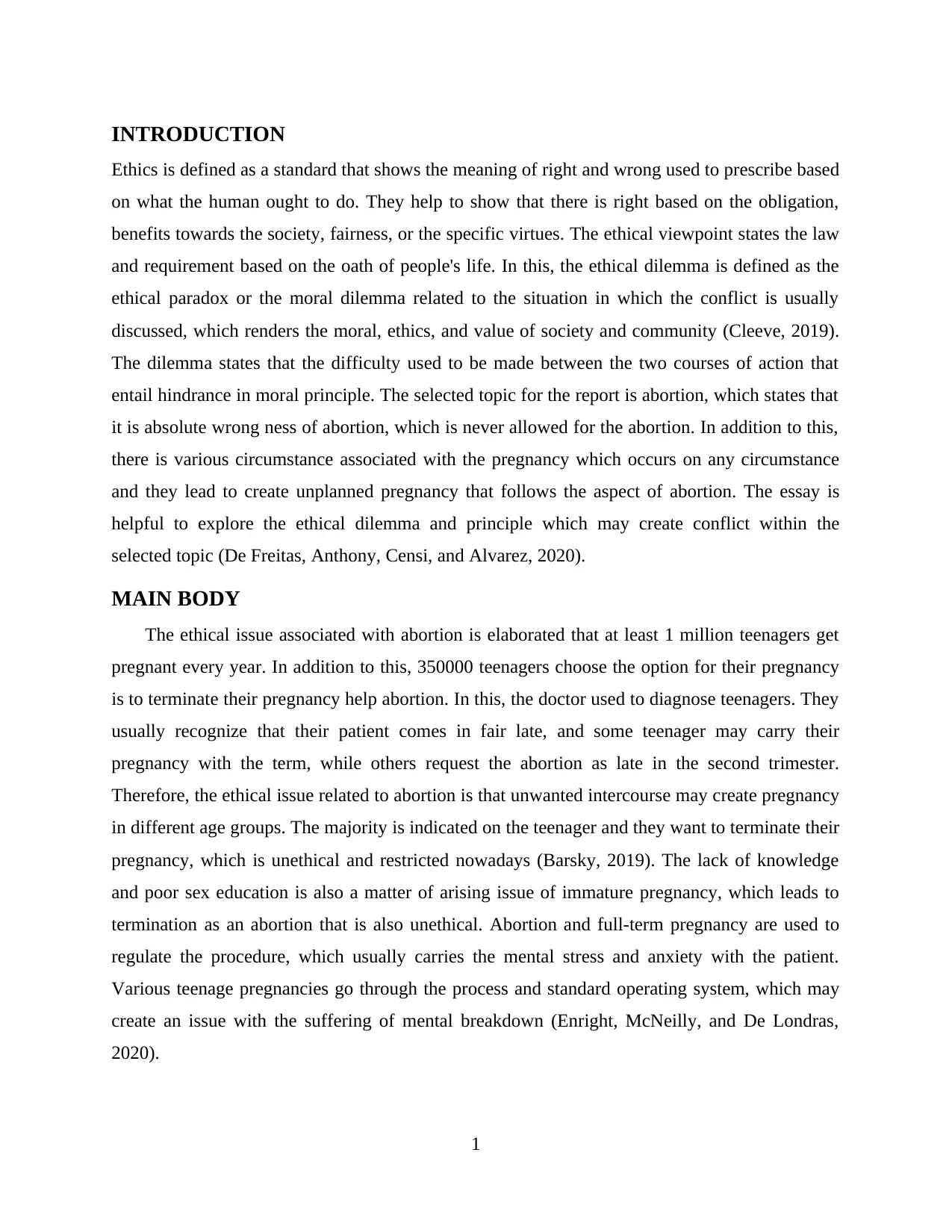
INTRODUCTION
Ethics is defined as a standard that shows the meaning of right and wrong used to prescribe based
on what the human ought to do. They help to show that there is right based on the obligation,
benefits towards the society, fairness, or the specific virtues. The ethical viewpoint states the law
and requirement based on the oath of people's life. In this, the ethical dilemma is defined as the
ethical paradox or the moral dilemma related to the situation in which the conflict is usually
discussed, which renders the moral, ethics, and value of society and community (Cleeve, 2019).
The dilemma states that the difficulty used to be made between the two courses of action that
entail hindrance in moral principle. The selected topic for the report is abortion, which states that
it is absolute wrong ness of abortion, which is never allowed for the abortion. In addition to this,
there is various circumstance associated with the pregnancy which occurs on any circumstance
and they lead to create unplanned pregnancy that follows the aspect of abortion. The essay is
helpful to explore the ethical dilemma and principle which may create conflict within the
selected topic (De Freitas, Anthony, Censi, and Alvarez, 2020).
MAIN BODY
The ethical issue associated with abortion is elaborated that at least 1 million teenagers get
pregnant every year. In addition to this, 350000 teenagers choose the option for their pregnancy
is to terminate their pregnancy help abortion. In this, the doctor used to diagnose teenagers. They
usually recognize that their patient comes in fair late, and some teenager may carry their
pregnancy with the term, while others request the abortion as late in the second trimester.
Therefore, the ethical issue related to abortion is that unwanted intercourse may create pregnancy
in different age groups. The majority is indicated on the teenager and they want to terminate their
pregnancy, which is unethical and restricted nowadays (Barsky, 2019). The lack of knowledge
and poor sex education is also a matter of arising issue of immature pregnancy, which leads to
termination as an abortion that is also unethical. Abortion and full-term pregnancy are used to
regulate the procedure, which usually carries the mental stress and anxiety with the patient.
Various teenage pregnancies go through the process and standard operating system, which may
create an issue with the suffering of mental breakdown (Enright, McNeilly, and De Londras,
2020).
1
Ethics is defined as a standard that shows the meaning of right and wrong used to prescribe based
on what the human ought to do. They help to show that there is right based on the obligation,
benefits towards the society, fairness, or the specific virtues. The ethical viewpoint states the law
and requirement based on the oath of people's life. In this, the ethical dilemma is defined as the
ethical paradox or the moral dilemma related to the situation in which the conflict is usually
discussed, which renders the moral, ethics, and value of society and community (Cleeve, 2019).
The dilemma states that the difficulty used to be made between the two courses of action that
entail hindrance in moral principle. The selected topic for the report is abortion, which states that
it is absolute wrong ness of abortion, which is never allowed for the abortion. In addition to this,
there is various circumstance associated with the pregnancy which occurs on any circumstance
and they lead to create unplanned pregnancy that follows the aspect of abortion. The essay is
helpful to explore the ethical dilemma and principle which may create conflict within the
selected topic (De Freitas, Anthony, Censi, and Alvarez, 2020).
MAIN BODY
The ethical issue associated with abortion is elaborated that at least 1 million teenagers get
pregnant every year. In addition to this, 350000 teenagers choose the option for their pregnancy
is to terminate their pregnancy help abortion. In this, the doctor used to diagnose teenagers. They
usually recognize that their patient comes in fair late, and some teenager may carry their
pregnancy with the term, while others request the abortion as late in the second trimester.
Therefore, the ethical issue related to abortion is that unwanted intercourse may create pregnancy
in different age groups. The majority is indicated on the teenager and they want to terminate their
pregnancy, which is unethical and restricted nowadays (Barsky, 2019). The lack of knowledge
and poor sex education is also a matter of arising issue of immature pregnancy, which leads to
termination as an abortion that is also unethical. Abortion and full-term pregnancy are used to
regulate the procedure, which usually carries the mental stress and anxiety with the patient.
Various teenage pregnancies go through the process and standard operating system, which may
create an issue with the suffering of mental breakdown (Enright, McNeilly, and De Londras,
2020).
1
⊘ This is a preview!⊘
Do you want full access?
Subscribe today to unlock all pages.

Trusted by 1+ million students worldwide
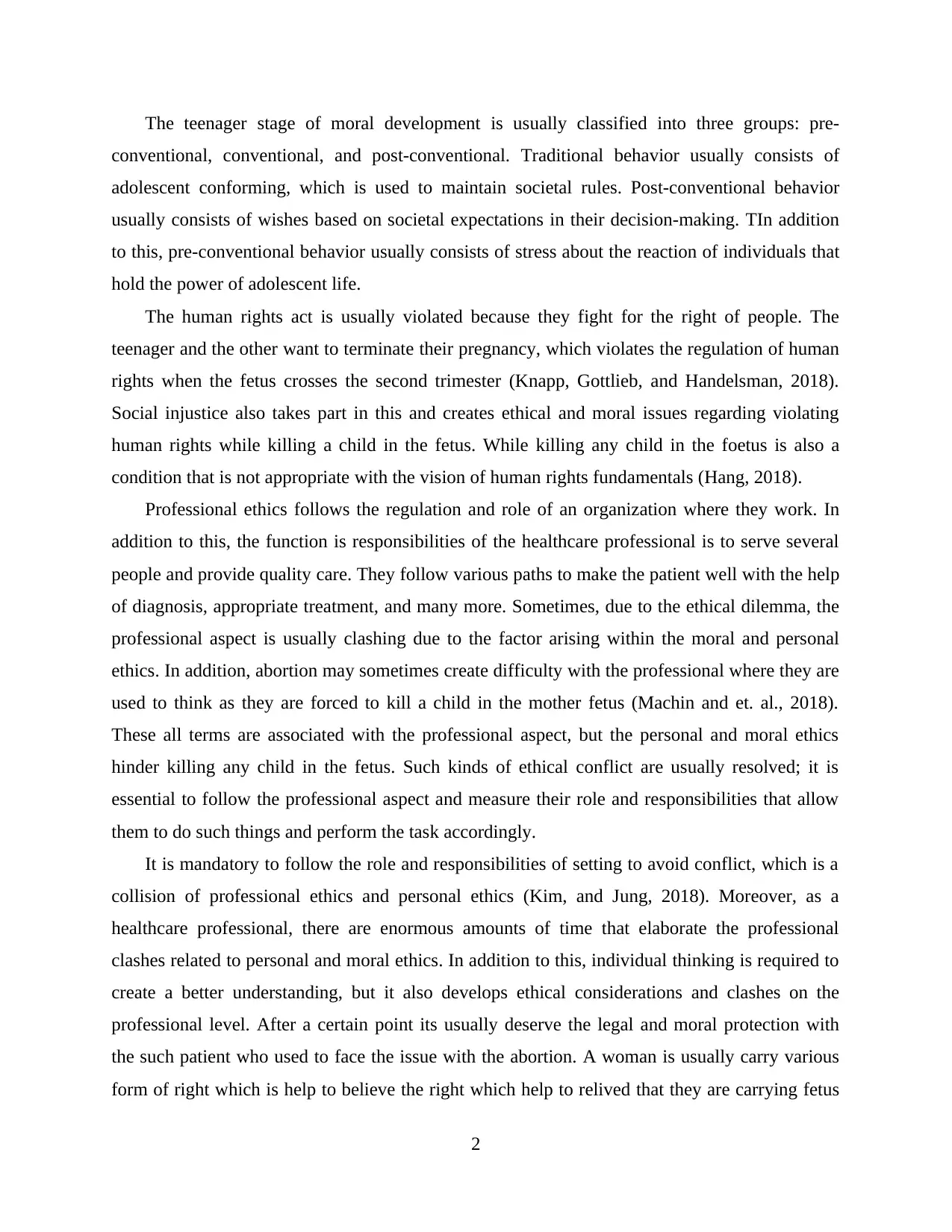
The teenager stage of moral development is usually classified into three groups: pre-
conventional, conventional, and post-conventional. Traditional behavior usually consists of
adolescent conforming, which is used to maintain societal rules. Post-conventional behavior
usually consists of wishes based on societal expectations in their decision-making. TIn addition
to this, pre-conventional behavior usually consists of stress about the reaction of individuals that
hold the power of adolescent life.
The human rights act is usually violated because they fight for the right of people. The
teenager and the other want to terminate their pregnancy, which violates the regulation of human
rights when the fetus crosses the second trimester (Knapp, Gottlieb, and Handelsman, 2018).
Social injustice also takes part in this and creates ethical and moral issues regarding violating
human rights while killing a child in the fetus. While killing any child in the foetus is also a
condition that is not appropriate with the vision of human rights fundamentals (Hang, 2018).
Professional ethics follows the regulation and role of an organization where they work. In
addition to this, the function is responsibilities of the healthcare professional is to serve several
people and provide quality care. They follow various paths to make the patient well with the help
of diagnosis, appropriate treatment, and many more. Sometimes, due to the ethical dilemma, the
professional aspect is usually clashing due to the factor arising within the moral and personal
ethics. In addition, abortion may sometimes create difficulty with the professional where they are
used to think as they are forced to kill a child in the mother fetus (Machin and et. al., 2018).
These all terms are associated with the professional aspect, but the personal and moral ethics
hinder killing any child in the fetus. Such kinds of ethical conflict are usually resolved; it is
essential to follow the professional aspect and measure their role and responsibilities that allow
them to do such things and perform the task accordingly.
It is mandatory to follow the role and responsibilities of setting to avoid conflict, which is a
collision of professional ethics and personal ethics (Kim, and Jung, 2018). Moreover, as a
healthcare professional, there are enormous amounts of time that elaborate the professional
clashes related to personal and moral ethics. In addition to this, individual thinking is required to
create a better understanding, but it also develops ethical considerations and clashes on the
professional level. After a certain point its usually deserve the legal and moral protection with
the such patient who used to face the issue with the abortion. A woman is usually carry various
form of right which is help to believe the right which help to relived that they are carrying fetus
2
conventional, conventional, and post-conventional. Traditional behavior usually consists of
adolescent conforming, which is used to maintain societal rules. Post-conventional behavior
usually consists of wishes based on societal expectations in their decision-making. TIn addition
to this, pre-conventional behavior usually consists of stress about the reaction of individuals that
hold the power of adolescent life.
The human rights act is usually violated because they fight for the right of people. The
teenager and the other want to terminate their pregnancy, which violates the regulation of human
rights when the fetus crosses the second trimester (Knapp, Gottlieb, and Handelsman, 2018).
Social injustice also takes part in this and creates ethical and moral issues regarding violating
human rights while killing a child in the fetus. While killing any child in the foetus is also a
condition that is not appropriate with the vision of human rights fundamentals (Hang, 2018).
Professional ethics follows the regulation and role of an organization where they work. In
addition to this, the function is responsibilities of the healthcare professional is to serve several
people and provide quality care. They follow various paths to make the patient well with the help
of diagnosis, appropriate treatment, and many more. Sometimes, due to the ethical dilemma, the
professional aspect is usually clashing due to the factor arising within the moral and personal
ethics. In addition, abortion may sometimes create difficulty with the professional where they are
used to think as they are forced to kill a child in the mother fetus (Machin and et. al., 2018).
These all terms are associated with the professional aspect, but the personal and moral ethics
hinder killing any child in the fetus. Such kinds of ethical conflict are usually resolved; it is
essential to follow the professional aspect and measure their role and responsibilities that allow
them to do such things and perform the task accordingly.
It is mandatory to follow the role and responsibilities of setting to avoid conflict, which is a
collision of professional ethics and personal ethics (Kim, and Jung, 2018). Moreover, as a
healthcare professional, there are enormous amounts of time that elaborate the professional
clashes related to personal and moral ethics. In addition to this, individual thinking is required to
create a better understanding, but it also develops ethical considerations and clashes on the
professional level. After a certain point its usually deserve the legal and moral protection with
the such patient who used to face the issue with the abortion. A woman is usually carry various
form of right which is help to believe the right which help to relived that they are carrying fetus
2
Paraphrase This Document
Need a fresh take? Get an instant paraphrase of this document with our AI Paraphraser
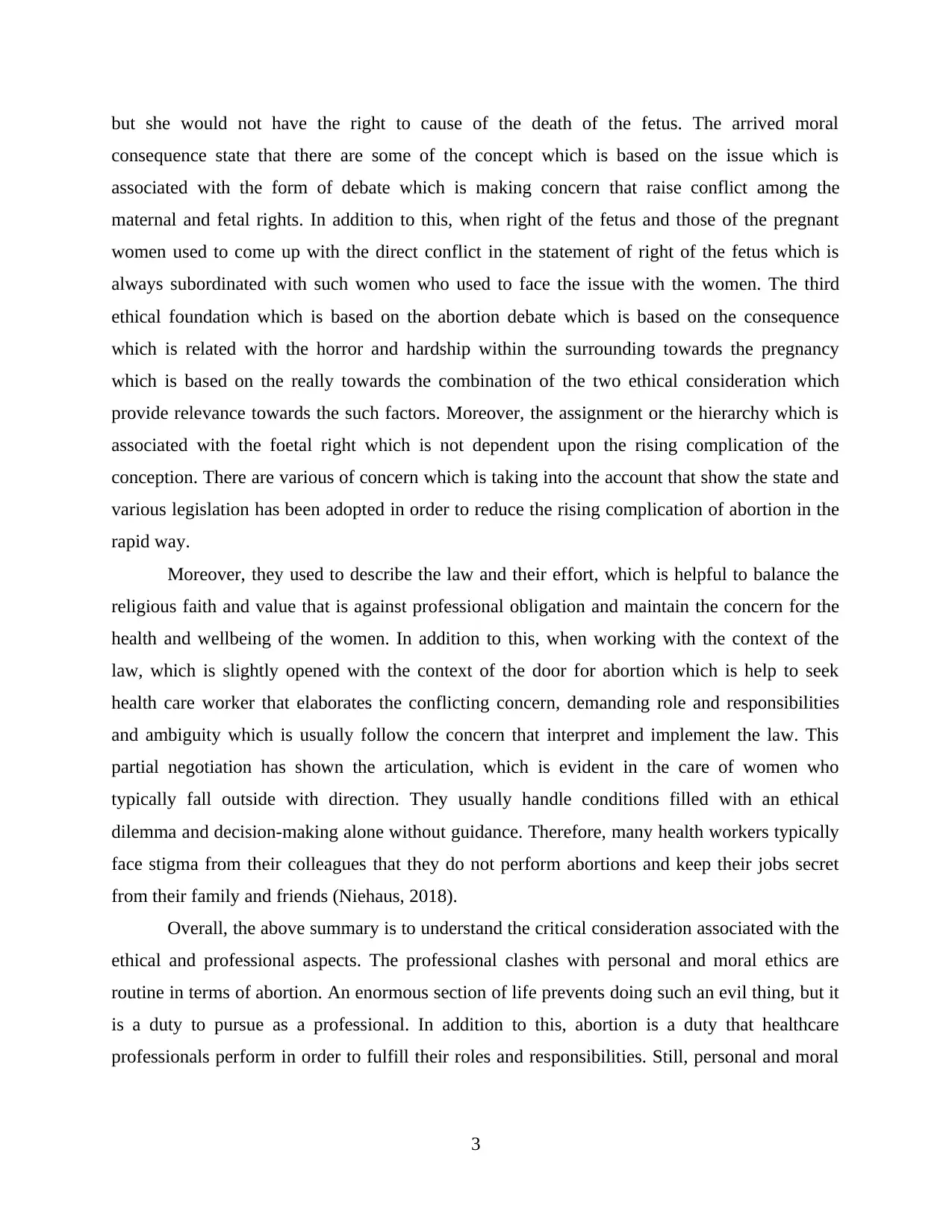
but she would not have the right to cause of the death of the fetus. The arrived moral
consequence state that there are some of the concept which is based on the issue which is
associated with the form of debate which is making concern that raise conflict among the
maternal and fetal rights. In addition to this, when right of the fetus and those of the pregnant
women used to come up with the direct conflict in the statement of right of the fetus which is
always subordinated with such women who used to face the issue with the women. The third
ethical foundation which is based on the abortion debate which is based on the consequence
which is related with the horror and hardship within the surrounding towards the pregnancy
which is based on the really towards the combination of the two ethical consideration which
provide relevance towards the such factors. Moreover, the assignment or the hierarchy which is
associated with the foetal right which is not dependent upon the rising complication of the
conception. There are various of concern which is taking into the account that show the state and
various legislation has been adopted in order to reduce the rising complication of abortion in the
rapid way.
Moreover, they used to describe the law and their effort, which is helpful to balance the
religious faith and value that is against professional obligation and maintain the concern for the
health and wellbeing of the women. In addition to this, when working with the context of the
law, which is slightly opened with the context of the door for abortion which is help to seek
health care worker that elaborates the conflicting concern, demanding role and responsibilities
and ambiguity which is usually follow the concern that interpret and implement the law. This
partial negotiation has shown the articulation, which is evident in the care of women who
typically fall outside with direction. They usually handle conditions filled with an ethical
dilemma and decision-making alone without guidance. Therefore, many health workers typically
face stigma from their colleagues that they do not perform abortions and keep their jobs secret
from their family and friends (Niehaus, 2018).
Overall, the above summary is to understand the critical consideration associated with the
ethical and professional aspects. The professional clashes with personal and moral ethics are
routine in terms of abortion. An enormous section of life prevents doing such an evil thing, but it
is a duty to pursue as a professional. In addition to this, abortion is a duty that healthcare
professionals perform in order to fulfill their roles and responsibilities. Still, personal and moral
3
consequence state that there are some of the concept which is based on the issue which is
associated with the form of debate which is making concern that raise conflict among the
maternal and fetal rights. In addition to this, when right of the fetus and those of the pregnant
women used to come up with the direct conflict in the statement of right of the fetus which is
always subordinated with such women who used to face the issue with the women. The third
ethical foundation which is based on the abortion debate which is based on the consequence
which is related with the horror and hardship within the surrounding towards the pregnancy
which is based on the really towards the combination of the two ethical consideration which
provide relevance towards the such factors. Moreover, the assignment or the hierarchy which is
associated with the foetal right which is not dependent upon the rising complication of the
conception. There are various of concern which is taking into the account that show the state and
various legislation has been adopted in order to reduce the rising complication of abortion in the
rapid way.
Moreover, they used to describe the law and their effort, which is helpful to balance the
religious faith and value that is against professional obligation and maintain the concern for the
health and wellbeing of the women. In addition to this, when working with the context of the
law, which is slightly opened with the context of the door for abortion which is help to seek
health care worker that elaborates the conflicting concern, demanding role and responsibilities
and ambiguity which is usually follow the concern that interpret and implement the law. This
partial negotiation has shown the articulation, which is evident in the care of women who
typically fall outside with direction. They usually handle conditions filled with an ethical
dilemma and decision-making alone without guidance. Therefore, many health workers typically
face stigma from their colleagues that they do not perform abortions and keep their jobs secret
from their family and friends (Niehaus, 2018).
Overall, the above summary is to understand the critical consideration associated with the
ethical and professional aspects. The professional clashes with personal and moral ethics are
routine in terms of abortion. An enormous section of life prevents doing such an evil thing, but it
is a duty to pursue as a professional. In addition to this, abortion is a duty that healthcare
professionals perform in order to fulfill their roles and responsibilities. Still, personal and moral
3
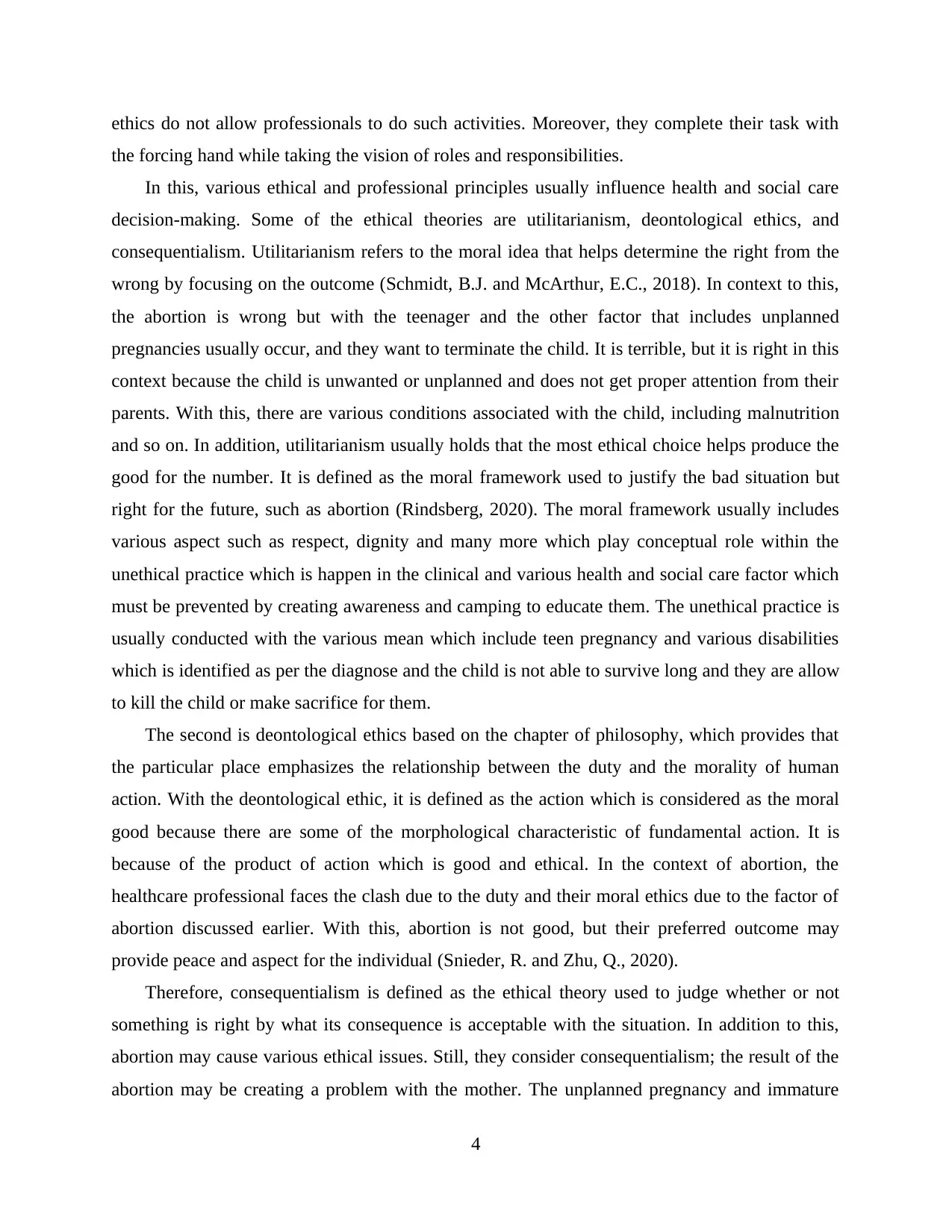
ethics do not allow professionals to do such activities. Moreover, they complete their task with
the forcing hand while taking the vision of roles and responsibilities.
In this, various ethical and professional principles usually influence health and social care
decision-making. Some of the ethical theories are utilitarianism, deontological ethics, and
consequentialism. Utilitarianism refers to the moral idea that helps determine the right from the
wrong by focusing on the outcome (Schmidt, B.J. and McArthur, E.C., 2018). In context to this,
the abortion is wrong but with the teenager and the other factor that includes unplanned
pregnancies usually occur, and they want to terminate the child. It is terrible, but it is right in this
context because the child is unwanted or unplanned and does not get proper attention from their
parents. With this, there are various conditions associated with the child, including malnutrition
and so on. In addition, utilitarianism usually holds that the most ethical choice helps produce the
good for the number. It is defined as the moral framework used to justify the bad situation but
right for the future, such as abortion (Rindsberg, 2020). The moral framework usually includes
various aspect such as respect, dignity and many more which play conceptual role within the
unethical practice which is happen in the clinical and various health and social care factor which
must be prevented by creating awareness and camping to educate them. The unethical practice is
usually conducted with the various mean which include teen pregnancy and various disabilities
which is identified as per the diagnose and the child is not able to survive long and they are allow
to kill the child or make sacrifice for them.
The second is deontological ethics based on the chapter of philosophy, which provides that
the particular place emphasizes the relationship between the duty and the morality of human
action. With the deontological ethic, it is defined as the action which is considered as the moral
good because there are some of the morphological characteristic of fundamental action. It is
because of the product of action which is good and ethical. In the context of abortion, the
healthcare professional faces the clash due to the duty and their moral ethics due to the factor of
abortion discussed earlier. With this, abortion is not good, but their preferred outcome may
provide peace and aspect for the individual (Snieder, R. and Zhu, Q., 2020).
Therefore, consequentialism is defined as the ethical theory used to judge whether or not
something is right by what its consequence is acceptable with the situation. In addition to this,
abortion may cause various ethical issues. Still, they consider consequentialism; the result of the
abortion may be creating a problem with the mother. The unplanned pregnancy and immature
4
the forcing hand while taking the vision of roles and responsibilities.
In this, various ethical and professional principles usually influence health and social care
decision-making. Some of the ethical theories are utilitarianism, deontological ethics, and
consequentialism. Utilitarianism refers to the moral idea that helps determine the right from the
wrong by focusing on the outcome (Schmidt, B.J. and McArthur, E.C., 2018). In context to this,
the abortion is wrong but with the teenager and the other factor that includes unplanned
pregnancies usually occur, and they want to terminate the child. It is terrible, but it is right in this
context because the child is unwanted or unplanned and does not get proper attention from their
parents. With this, there are various conditions associated with the child, including malnutrition
and so on. In addition, utilitarianism usually holds that the most ethical choice helps produce the
good for the number. It is defined as the moral framework used to justify the bad situation but
right for the future, such as abortion (Rindsberg, 2020). The moral framework usually includes
various aspect such as respect, dignity and many more which play conceptual role within the
unethical practice which is happen in the clinical and various health and social care factor which
must be prevented by creating awareness and camping to educate them. The unethical practice is
usually conducted with the various mean which include teen pregnancy and various disabilities
which is identified as per the diagnose and the child is not able to survive long and they are allow
to kill the child or make sacrifice for them.
The second is deontological ethics based on the chapter of philosophy, which provides that
the particular place emphasizes the relationship between the duty and the morality of human
action. With the deontological ethic, it is defined as the action which is considered as the moral
good because there are some of the morphological characteristic of fundamental action. It is
because of the product of action which is good and ethical. In the context of abortion, the
healthcare professional faces the clash due to the duty and their moral ethics due to the factor of
abortion discussed earlier. With this, abortion is not good, but their preferred outcome may
provide peace and aspect for the individual (Snieder, R. and Zhu, Q., 2020).
Therefore, consequentialism is defined as the ethical theory used to judge whether or not
something is right by what its consequence is acceptable with the situation. In addition to this,
abortion may cause various ethical issues. Still, they consider consequentialism; the result of the
abortion may be creating a problem with the mother. The unplanned pregnancy and immature
4
⊘ This is a preview!⊘
Do you want full access?
Subscribe today to unlock all pages.

Trusted by 1+ million students worldwide
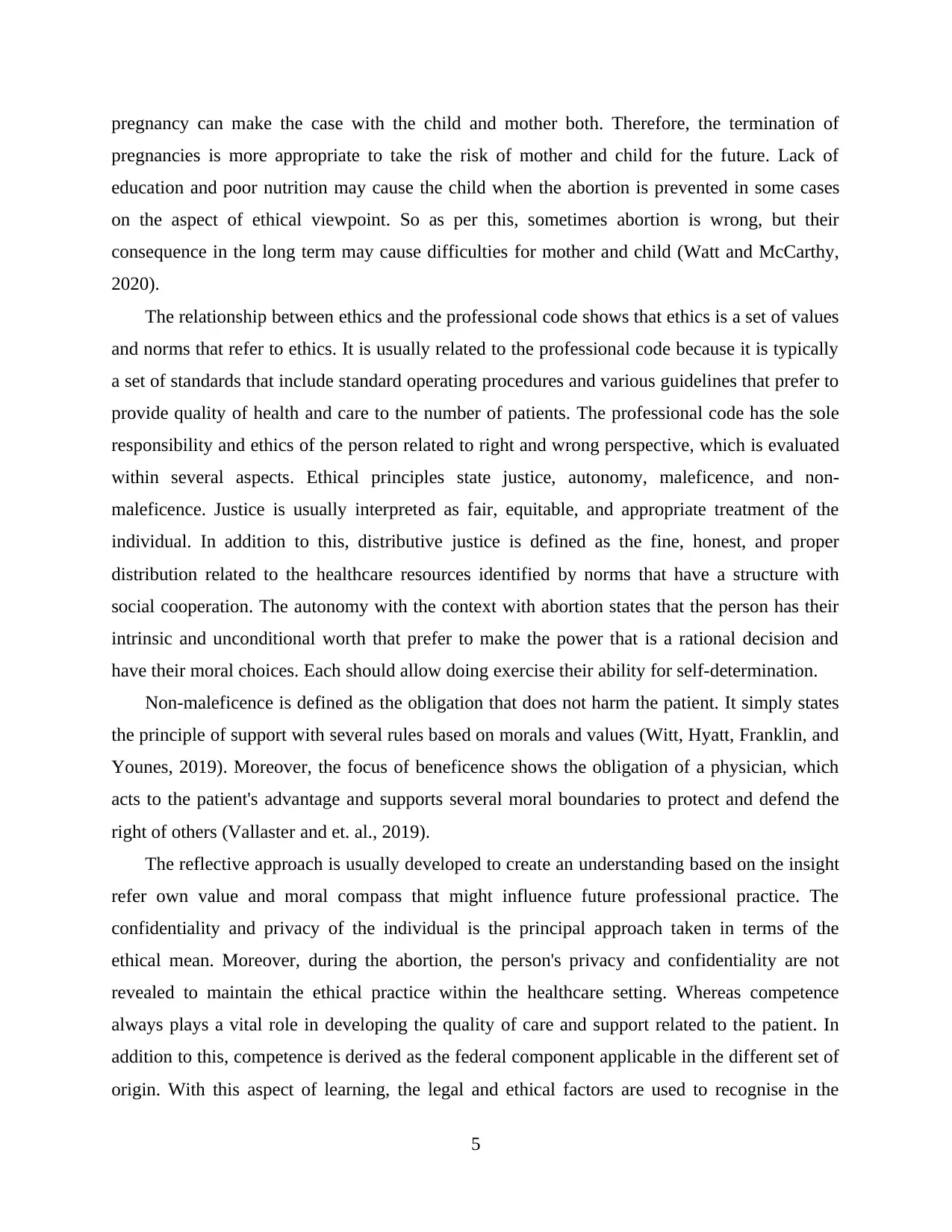
pregnancy can make the case with the child and mother both. Therefore, the termination of
pregnancies is more appropriate to take the risk of mother and child for the future. Lack of
education and poor nutrition may cause the child when the abortion is prevented in some cases
on the aspect of ethical viewpoint. So as per this, sometimes abortion is wrong, but their
consequence in the long term may cause difficulties for mother and child (Watt and McCarthy,
2020).
The relationship between ethics and the professional code shows that ethics is a set of values
and norms that refer to ethics. It is usually related to the professional code because it is typically
a set of standards that include standard operating procedures and various guidelines that prefer to
provide quality of health and care to the number of patients. The professional code has the sole
responsibility and ethics of the person related to right and wrong perspective, which is evaluated
within several aspects. Ethical principles state justice, autonomy, maleficence, and non-
maleficence. Justice is usually interpreted as fair, equitable, and appropriate treatment of the
individual. In addition to this, distributive justice is defined as the fine, honest, and proper
distribution related to the healthcare resources identified by norms that have a structure with
social cooperation. The autonomy with the context with abortion states that the person has their
intrinsic and unconditional worth that prefer to make the power that is a rational decision and
have their moral choices. Each should allow doing exercise their ability for self-determination.
Non-maleficence is defined as the obligation that does not harm the patient. It simply states
the principle of support with several rules based on morals and values (Witt, Hyatt, Franklin, and
Younes, 2019). Moreover, the focus of beneficence shows the obligation of a physician, which
acts to the patient's advantage and supports several moral boundaries to protect and defend the
right of others (Vallaster and et. al., 2019).
The reflective approach is usually developed to create an understanding based on the insight
refer own value and moral compass that might influence future professional practice. The
confidentiality and privacy of the individual is the principal approach taken in terms of the
ethical mean. Moreover, during the abortion, the person's privacy and confidentiality are not
revealed to maintain the ethical practice within the healthcare setting. Whereas competence
always plays a vital role in developing the quality of care and support related to the patient. In
addition to this, competence is derived as the federal component applicable in the different set of
origin. With this aspect of learning, the legal and ethical factors are used to recognise in the
5
pregnancies is more appropriate to take the risk of mother and child for the future. Lack of
education and poor nutrition may cause the child when the abortion is prevented in some cases
on the aspect of ethical viewpoint. So as per this, sometimes abortion is wrong, but their
consequence in the long term may cause difficulties for mother and child (Watt and McCarthy,
2020).
The relationship between ethics and the professional code shows that ethics is a set of values
and norms that refer to ethics. It is usually related to the professional code because it is typically
a set of standards that include standard operating procedures and various guidelines that prefer to
provide quality of health and care to the number of patients. The professional code has the sole
responsibility and ethics of the person related to right and wrong perspective, which is evaluated
within several aspects. Ethical principles state justice, autonomy, maleficence, and non-
maleficence. Justice is usually interpreted as fair, equitable, and appropriate treatment of the
individual. In addition to this, distributive justice is defined as the fine, honest, and proper
distribution related to the healthcare resources identified by norms that have a structure with
social cooperation. The autonomy with the context with abortion states that the person has their
intrinsic and unconditional worth that prefer to make the power that is a rational decision and
have their moral choices. Each should allow doing exercise their ability for self-determination.
Non-maleficence is defined as the obligation that does not harm the patient. It simply states
the principle of support with several rules based on morals and values (Witt, Hyatt, Franklin, and
Younes, 2019). Moreover, the focus of beneficence shows the obligation of a physician, which
acts to the patient's advantage and supports several moral boundaries to protect and defend the
right of others (Vallaster and et. al., 2019).
The reflective approach is usually developed to create an understanding based on the insight
refer own value and moral compass that might influence future professional practice. The
confidentiality and privacy of the individual is the principal approach taken in terms of the
ethical mean. Moreover, during the abortion, the person's privacy and confidentiality are not
revealed to maintain the ethical practice within the healthcare setting. Whereas competence
always plays a vital role in developing the quality of care and support related to the patient. In
addition to this, competence is derived as the federal component applicable in the different set of
origin. With this aspect of learning, the legal and ethical factors are used to recognise in the
5
Paraphrase This Document
Need a fresh take? Get an instant paraphrase of this document with our AI Paraphraser
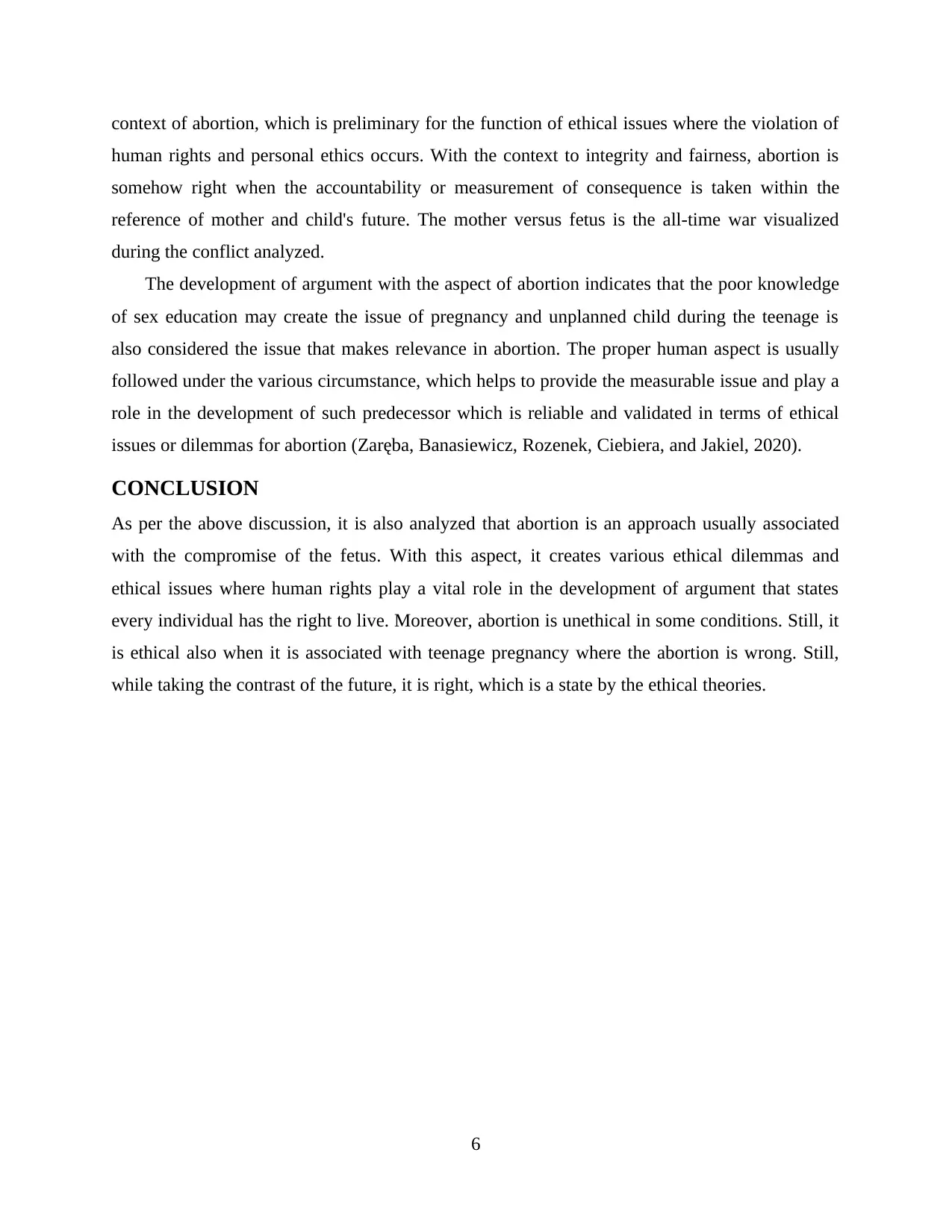
context of abortion, which is preliminary for the function of ethical issues where the violation of
human rights and personal ethics occurs. With the context to integrity and fairness, abortion is
somehow right when the accountability or measurement of consequence is taken within the
reference of mother and child's future. The mother versus fetus is the all-time war visualized
during the conflict analyzed.
The development of argument with the aspect of abortion indicates that the poor knowledge
of sex education may create the issue of pregnancy and unplanned child during the teenage is
also considered the issue that makes relevance in abortion. The proper human aspect is usually
followed under the various circumstance, which helps to provide the measurable issue and play a
role in the development of such predecessor which is reliable and validated in terms of ethical
issues or dilemmas for abortion (Zaręba, Banasiewicz, Rozenek, Ciebiera, and Jakiel, 2020).
CONCLUSION
As per the above discussion, it is also analyzed that abortion is an approach usually associated
with the compromise of the fetus. With this aspect, it creates various ethical dilemmas and
ethical issues where human rights play a vital role in the development of argument that states
every individual has the right to live. Moreover, abortion is unethical in some conditions. Still, it
is ethical also when it is associated with teenage pregnancy where the abortion is wrong. Still,
while taking the contrast of the future, it is right, which is a state by the ethical theories.
6
human rights and personal ethics occurs. With the context to integrity and fairness, abortion is
somehow right when the accountability or measurement of consequence is taken within the
reference of mother and child's future. The mother versus fetus is the all-time war visualized
during the conflict analyzed.
The development of argument with the aspect of abortion indicates that the poor knowledge
of sex education may create the issue of pregnancy and unplanned child during the teenage is
also considered the issue that makes relevance in abortion. The proper human aspect is usually
followed under the various circumstance, which helps to provide the measurable issue and play a
role in the development of such predecessor which is reliable and validated in terms of ethical
issues or dilemmas for abortion (Zaręba, Banasiewicz, Rozenek, Ciebiera, and Jakiel, 2020).
CONCLUSION
As per the above discussion, it is also analyzed that abortion is an approach usually associated
with the compromise of the fetus. With this aspect, it creates various ethical dilemmas and
ethical issues where human rights play a vital role in the development of argument that states
every individual has the right to live. Moreover, abortion is unethical in some conditions. Still, it
is ethical also when it is associated with teenage pregnancy where the abortion is wrong. Still,
while taking the contrast of the future, it is right, which is a state by the ethical theories.
6
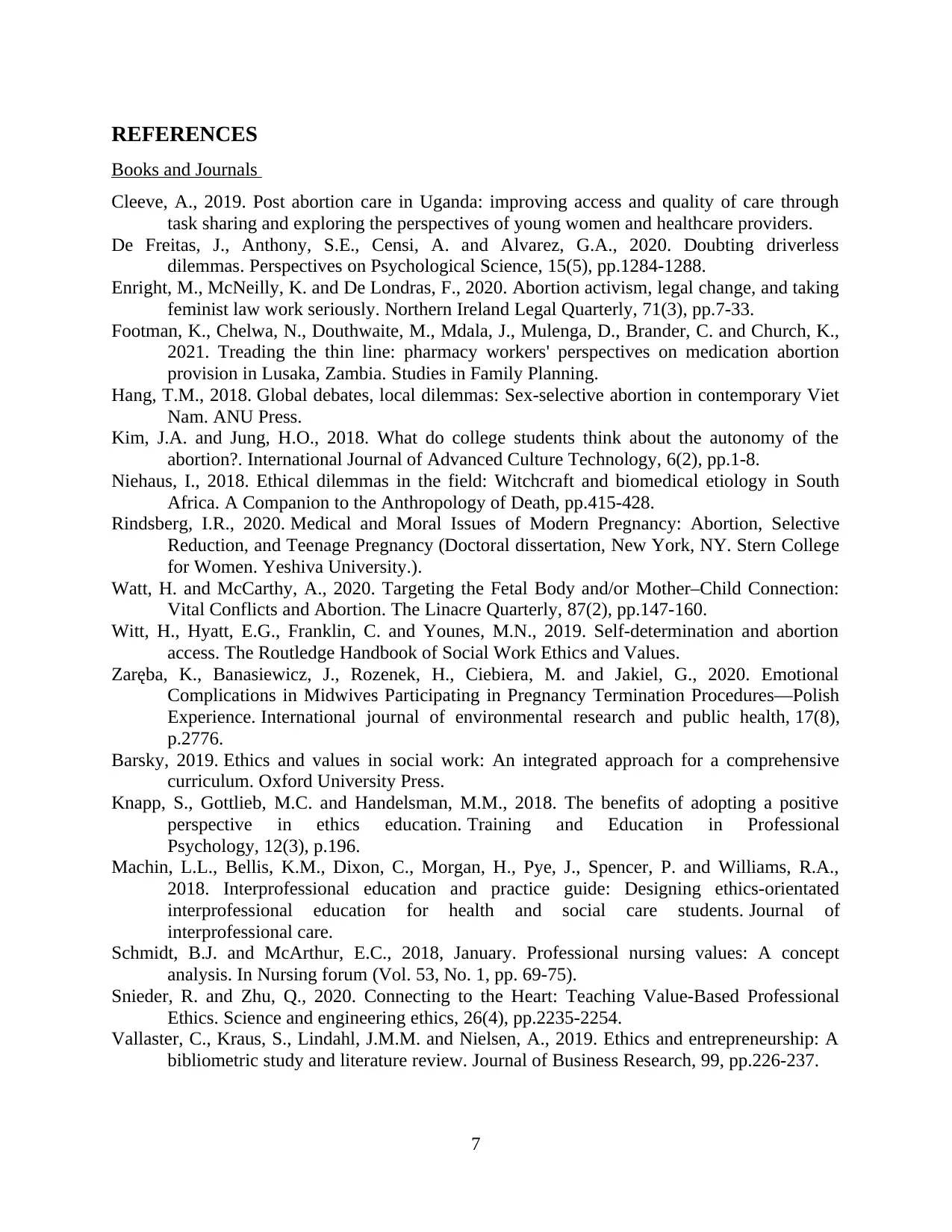
REFERENCES
Books and Journals
Cleeve, A., 2019. Post abortion care in Uganda: improving access and quality of care through
task sharing and exploring the perspectives of young women and healthcare providers.
De Freitas, J., Anthony, S.E., Censi, A. and Alvarez, G.A., 2020. Doubting driverless
dilemmas. Perspectives on Psychological Science, 15(5), pp.1284-1288.
Enright, M., McNeilly, K. and De Londras, F., 2020. Abortion activism, legal change, and taking
feminist law work seriously. Northern Ireland Legal Quarterly, 71(3), pp.7-33.
Footman, K., Chelwa, N., Douthwaite, M., Mdala, J., Mulenga, D., Brander, C. and Church, K.,
2021. Treading the thin line: pharmacy workers' perspectives on medication abortion
provision in Lusaka, Zambia. Studies in Family Planning.
Hang, T.M., 2018. Global debates, local dilemmas: Sex-selective abortion in contemporary Viet
Nam. ANU Press.
Kim, J.A. and Jung, H.O., 2018. What do college students think about the autonomy of the
abortion?. International Journal of Advanced Culture Technology, 6(2), pp.1-8.
Niehaus, I., 2018. Ethical dilemmas in the field: Witchcraft and biomedical etiology in South
Africa. A Companion to the Anthropology of Death, pp.415-428.
Rindsberg, I.R., 2020. Medical and Moral Issues of Modern Pregnancy: Abortion, Selective
Reduction, and Teenage Pregnancy (Doctoral dissertation, New York, NY. Stern College
for Women. Yeshiva University.).
Watt, H. and McCarthy, A., 2020. Targeting the Fetal Body and/or Mother–Child Connection:
Vital Conflicts and Abortion. The Linacre Quarterly, 87(2), pp.147-160.
Witt, H., Hyatt, E.G., Franklin, C. and Younes, M.N., 2019. Self-determination and abortion
access. The Routledge Handbook of Social Work Ethics and Values.
Zaręba, K., Banasiewicz, J., Rozenek, H., Ciebiera, M. and Jakiel, G., 2020. Emotional
Complications in Midwives Participating in Pregnancy Termination Procedures—Polish
Experience. International journal of environmental research and public health, 17(8),
p.2776.
Barsky, 2019. Ethics and values in social work: An integrated approach for a comprehensive
curriculum. Oxford University Press.
Knapp, S., Gottlieb, M.C. and Handelsman, M.M., 2018. The benefits of adopting a positive
perspective in ethics education. Training and Education in Professional
Psychology, 12(3), p.196.
Machin, L.L., Bellis, K.M., Dixon, C., Morgan, H., Pye, J., Spencer, P. and Williams, R.A.,
2018. Interprofessional education and practice guide: Designing ethics-orientated
interprofessional education for health and social care students. Journal of
interprofessional care.
Schmidt, B.J. and McArthur, E.C., 2018, January. Professional nursing values: A concept
analysis. In Nursing forum (Vol. 53, No. 1, pp. 69-75).
Snieder, R. and Zhu, Q., 2020. Connecting to the Heart: Teaching Value-Based Professional
Ethics. Science and engineering ethics, 26(4), pp.2235-2254.
Vallaster, C., Kraus, S., Lindahl, J.M.M. and Nielsen, A., 2019. Ethics and entrepreneurship: A
bibliometric study and literature review. Journal of Business Research, 99, pp.226-237.
7
Books and Journals
Cleeve, A., 2019. Post abortion care in Uganda: improving access and quality of care through
task sharing and exploring the perspectives of young women and healthcare providers.
De Freitas, J., Anthony, S.E., Censi, A. and Alvarez, G.A., 2020. Doubting driverless
dilemmas. Perspectives on Psychological Science, 15(5), pp.1284-1288.
Enright, M., McNeilly, K. and De Londras, F., 2020. Abortion activism, legal change, and taking
feminist law work seriously. Northern Ireland Legal Quarterly, 71(3), pp.7-33.
Footman, K., Chelwa, N., Douthwaite, M., Mdala, J., Mulenga, D., Brander, C. and Church, K.,
2021. Treading the thin line: pharmacy workers' perspectives on medication abortion
provision in Lusaka, Zambia. Studies in Family Planning.
Hang, T.M., 2018. Global debates, local dilemmas: Sex-selective abortion in contemporary Viet
Nam. ANU Press.
Kim, J.A. and Jung, H.O., 2018. What do college students think about the autonomy of the
abortion?. International Journal of Advanced Culture Technology, 6(2), pp.1-8.
Niehaus, I., 2018. Ethical dilemmas in the field: Witchcraft and biomedical etiology in South
Africa. A Companion to the Anthropology of Death, pp.415-428.
Rindsberg, I.R., 2020. Medical and Moral Issues of Modern Pregnancy: Abortion, Selective
Reduction, and Teenage Pregnancy (Doctoral dissertation, New York, NY. Stern College
for Women. Yeshiva University.).
Watt, H. and McCarthy, A., 2020. Targeting the Fetal Body and/or Mother–Child Connection:
Vital Conflicts and Abortion. The Linacre Quarterly, 87(2), pp.147-160.
Witt, H., Hyatt, E.G., Franklin, C. and Younes, M.N., 2019. Self-determination and abortion
access. The Routledge Handbook of Social Work Ethics and Values.
Zaręba, K., Banasiewicz, J., Rozenek, H., Ciebiera, M. and Jakiel, G., 2020. Emotional
Complications in Midwives Participating in Pregnancy Termination Procedures—Polish
Experience. International journal of environmental research and public health, 17(8),
p.2776.
Barsky, 2019. Ethics and values in social work: An integrated approach for a comprehensive
curriculum. Oxford University Press.
Knapp, S., Gottlieb, M.C. and Handelsman, M.M., 2018. The benefits of adopting a positive
perspective in ethics education. Training and Education in Professional
Psychology, 12(3), p.196.
Machin, L.L., Bellis, K.M., Dixon, C., Morgan, H., Pye, J., Spencer, P. and Williams, R.A.,
2018. Interprofessional education and practice guide: Designing ethics-orientated
interprofessional education for health and social care students. Journal of
interprofessional care.
Schmidt, B.J. and McArthur, E.C., 2018, January. Professional nursing values: A concept
analysis. In Nursing forum (Vol. 53, No. 1, pp. 69-75).
Snieder, R. and Zhu, Q., 2020. Connecting to the Heart: Teaching Value-Based Professional
Ethics. Science and engineering ethics, 26(4), pp.2235-2254.
Vallaster, C., Kraus, S., Lindahl, J.M.M. and Nielsen, A., 2019. Ethics and entrepreneurship: A
bibliometric study and literature review. Journal of Business Research, 99, pp.226-237.
7
⊘ This is a preview!⊘
Do you want full access?
Subscribe today to unlock all pages.

Trusted by 1+ million students worldwide

8
1 out of 10
Related Documents
Your All-in-One AI-Powered Toolkit for Academic Success.
+13062052269
info@desklib.com
Available 24*7 on WhatsApp / Email
![[object Object]](/_next/static/media/star-bottom.7253800d.svg)
Unlock your academic potential
Copyright © 2020–2025 A2Z Services. All Rights Reserved. Developed and managed by ZUCOL.




